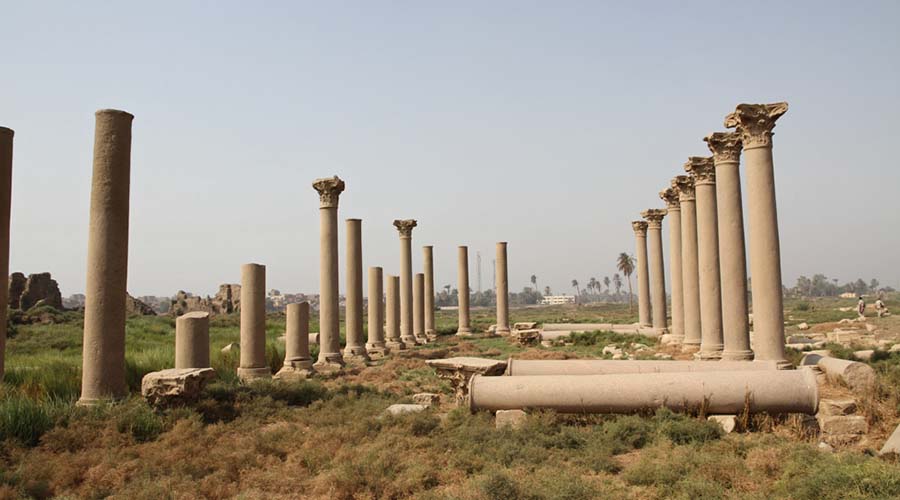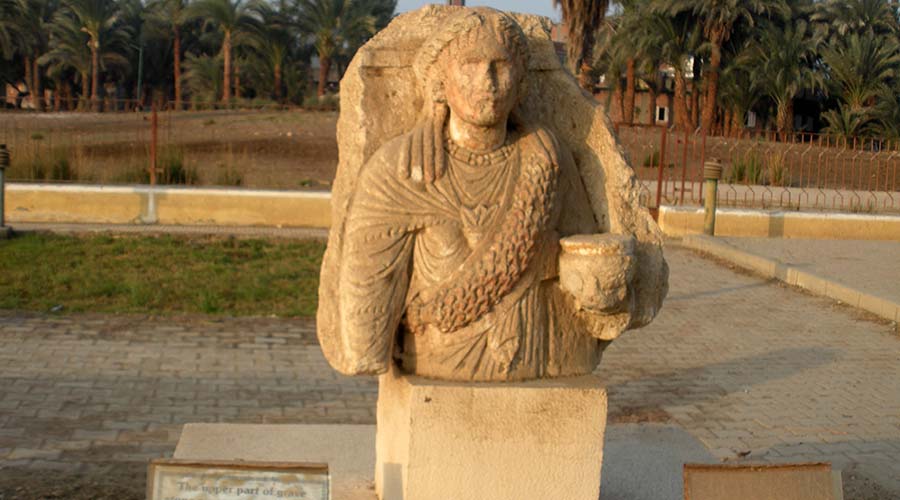Hermopolis El Minya Egypt tours, prices, booking, reviews
Hermopolis El Minya is a roman town located the near village of El Ashmunein El Miny, Egypt. In fact, the site located on the west bank of the Nile, north-west of Mallawi. Moreover, the town known as Khmun in Pharaonic times. During the Old Kingdom, the town was of a great importance as a cult center of Thoth, god of wisdom. In the Graeco-Roman Period, the city was the capital of the 15th Upper Egyptian Nome. In fact, the Greek god Hermes associated with the Egyptian Thoth. The last one dominated the site in the guise of two famous colossal baboon statues. Khmun, in the ancient Egyptian language means “town of eight”, named after the Ogdoad. These were eight primeval deities (four frog-gods and four snake-goddesses). In fact, they associated with the Hermopolitan creation myth. It was before they brought the primeval mound into being.
In fact, there are no remains of the earliest development of the city. Yet, the only surviving elements of the site now are crumbling mounds of mud-brick ruins. Moreover, the site also includes destroyed stone temples. In fact, the once great Temple of Thoth at Hermopolis visited by several early explorers. Moreover, in the early 19th century, some of the columns of the hypo-style hall were still standing. During the 1930 a German expedition directed by Gunter Roeder excavated the sites. In fact, they revealed a pylon of a temple which built by Ramses II. Moreover, they found over one thousand re-used talatat blocks. In fact, the blocks brought from the dismantled Aten temples at el-Amarna. The site also revealed mud brick houses. In fact, the houses back to the Third Intermediate Period as well as Roman monuments.
Further details about Hermopolis El Minya Egypt:
Most visitors will arrive first at the site of the old archaeological mission house. In fact, the house now turned into an open-air museum. The open air museum contains blocks, statues and stelae from excavations at the site. At the entrance to the museum, there are two huge baboon statues which reconstructed. In fact, their bodies are over 4.5 m high and represent the god Thoth. These are only two of several baboon colossi which erected at the site. In fact, it was during the reign of Amenhotep III (Dynasty XVIII). The site has also another road which leads to the east through an overgrown area. Moreover, the road also leads to the great Temple of Thoth. In fact, this temple indeed is one of the site’s main attractions. Moreover, the temple constructed in several stages throughout the city’s long history. The monuments at Hermopolis El Minya indeed suffered from stone quarrying.
In fact, it was from the early Christian times down to the early Islamic Period. Some of the stone masonry from the temple complex remained in place. The archaeologists uncovered foundations of the great pylon gateways. In fact, the great pylon gateways built by Horemheb and Ramses II. It was in this area that the re-used talatat blocks from Akhenaten’s city which found on the east bank. The largest remains of the temple of Thoth at Hermopolis date back to Necatnebo I reign. In fact, the last one rebuilt parts of the structure and enclosed the temple precinct. It was within huge mud-brick walls, 15 meters deep. Nectanebo’s gateway located on the southern side of the temple enclosure. Moreover, the gateway followed by the pylon of Ramses II and a processional way.
More details about Hermopolis El Minya Egypt:
Alexander the Great extended the Late Period temple by constructing a magnificent portico. In fact, the portico consists of two rows of six limestone columns. Moreover, it has much colorful decoration. Only the foundations of the columns remain today since the portico demolished in 1826 AC. Moreover, the stone reused in the building of a sugar factory. To the south-west of the temple are remains of an east-facing limestone sanctuary. In fact, the sanctuary dedicated to Amun and protected by a turreted fortress wall. The entrance pylon and part of the hypo-style hall of this structure still seen. Yet, the rear parts reduced to the ground level and surrounded by water. South-east of the Amun temple, there are remains of a monumental gateway. In fact, they date back to the late Middle Kingdom reign of Amenemhet II.
The remains of the facade and a passage of this structure still survive. Moreover, Hermopolis El Minya has another small temple which built in the reign of Ramses II. The small temple has additions by Nero. It is where two seated colossi of Ramses stood before the entrance. On the edge of the village there are fragmentary remains of a temple. In fact, this temple dedicated to the goddess Nehemetaway, the wife of Thoth. Moreover, this temple was the latest temple which built at the site. Outside the temple enclosure on the eastern side of the site are remains of a Roman Agora. Moreover, there are also a restored Coptic basilica which constructed with many blocks. In fact, the blocks are from Ptolemaic monuments and follow a Greek style of architecture. Most of the graceful granite columns still stand in the structure of the church.
Further details about Hermopolis El Minya Egypt:
In fact, it is the best example of a monument from this period in Egypt. Nearby, there is a long architrave which inscribed with a Greek text and lies on the ground. The British Museum excavation team also uncovered parts of the town site of the site. At the western side of Hermopolis El Minya site, there are mud-brick houses. In fact, the houses date back to the Third Intermediate Period. The majority of buildings belonged to the wealthier families of the town. Three successive levels of construction identified. In the Graeco-Roman part of the town, the “Dromos of Hermes” uncovered. In fact, its existence known from papyrus texts. There is also a paved processional street which runs from north to south through the city. In fact, this street contained re-used stone from earlier times. One of these elements is an alabaster altar which inscribed with scenes and titles.
In fact, the scenes and titles were of Amenhotep III. The Graeco-Roman parts of the Hermopolis El Minya built over many earlier destroyed structures. In fact, these structures date back to the New Kingdom and Third Intermediate Period. Over 300 fragments from a large alabaster stelae of Osorkon III also discovered. In fact, they date back to the Third Intermediate Period. The oldest feature which found at the site was a Middle Kingdom cemetery. In fact, the cemetery also excavated in the 1980 by the British Museum team. Moreoevr, the cemetery enclosed by a massive mud-brick wall. Furthermore, the tombs consist of small vaulted chambers with a superstructure. Over time, new graves superimposed over older ones to the top of the enclosure. In fact, many pottery jars found at the site. The later cemetery which associated with the site can seen now at Tuna El Gebel.
How to get to Hermopoils:
Hermopolis located on the west bank of the Nile. Moreover, the town is about 8 km north of Mallawi and 7 km east of Tuna El Gebel. The ticket office for the site is at the open-air museum and tickets cost 35 Egyptian pound.
















